Within limits
Jo Wakelin lives in New Zealand’s driest region but that hasn’t stopped her creating a garden recognised as one of the world’s best.
In its breathtaking setting at the foot of the Pisa Range Jo’s Garden has attracted the attention of international garden writers and photographers.
The striking arrangement of different plant colours and shapes disguises this garden’s most remarkable point of difference - that its plants live solely on what little water falls from the sky.
Jo is a botanist driven by a sheer love of plants and a conviction that selecting plants to suit the soil and climate we are given, rather than trying to adjust the conditions to suit the plants, is the only way to go.
Raised on a high-country sheep station, she seems as well adapted to her landscape as her plants. She learned the preciousness of water early, saying, “My grandmother gardened very successfully in Wanaka without irrigation before polythene pipe was invented,” she says.
A love of tramping and the great outdoors led young Jo to a science degree majoring in Botany at Otago University. “There was a strong focus on NZ ecology, which of course meant trips to the Central Otago mountains!” This became the basis of her horticulture career and for many years now she has been teaching students at Otago Polytechnic’s Central campus how to propagate, grow and select appropriate plants.
Jo says some thought her mad when in 2007 she decided her new garden, on its wild windy site with very gravelly soil, would be totally irrigation free. The annual rainfall in her first year was less than 300mm. Add Central Otago’s searing summer heat, winter frosts and huge rabbit population and the challenges she faces couldn’t seem more extreme.
The extra limitations of a busy lifestyle, balancing full time work as a lecturer along with teenage children, further fueled Jo's desire for low maintenance garden. Not having a garden at all was clearly not an option for this plant lover as she followed her dream to create a beautiful garden that would look after itself without watering.
Her plant search involved many hours spent poring over books and catalogues as well as visits to dry gardens far and near. There was, she reports, “Some surreptitious stalking of unloved gardens and old miner's cottages around Central Otago.”
Jo’s travels have taken her to some of the world’s most famous dry gardens. “I visited Beth Chatto’s dry garden (in England) many years ago which was inspirational, and more recently a stroll in Olivier Filippi’s amazing garden (in Southern France) fired me up. Currently my inspirational landscape designer is Miguel Urquijo from the semi-arid climate in Spain, who also believes sustainability is the future for garden design.”
Jo’s closely curated collection of robust survivors is surprisingly diverse. Looking like they always belonged together, treasures from other dry windswept regions of the world happily intermingle with our tough NZ natives.
Of course Otago’s own locals are especially well suited, and Jo has some favourites. “I absolutely love our tough local kōwhai species – Sophora microphylla,” she reveals. “I’ve grown my own kōwhai trees from seeds I’ve collected from relict old man trees surviving on rocky crags in the local mountains.”
To visually blend her garden into the surrounding landscape she has planted huge sweeping swathes of the native silver tussock, Poa cita. Their silky strands moving in the wind a perfect foreground for the water and mountain view.
Mediterranean plants are very much at home here, including lavenders, rock roses, euphorbias, verbascum, bearded irises (dwarf forms cope best in the wind), spring flowering species tulips, alliums, mascara (grape hyacinths) and miniature daffodils, plus the autumn flowering crocus.
Plants that grow from bulbs and fleshy rhizomes are some of Jo’s top performers, retreating below ground for the brutal summer season, and popping up again after autumn rains to provide welcome colour over the cooler months.
Low mounding and dome shapes are an attractive feature of any successful windy garden. One of Jo’s favourites is sage green Ballota pseudodictamnus, an extremely tough plant forming tidy mounds of furry foliage. Frost hardy succulents are obvious stalwarts in this climate and the lovely Sedum 'Purple Emperor' performs well for Jo. Artemisia 'Powis Castle’ provides extra foliage contrast in glistening silver. Russian sage (Perovskia atriplicifolia) with its mass of long purple flower spikes adds textural contrast.
Jo has planted a variety Phlomis, a genus of perennials well known for its dry tolerance. “One of my current favourites is Phlomis tuberosa Amazone,” she says. “It provides a wonderful vertical element. In its native habitat it grows in dry, rocky ground in southern Europe so suits Central Otago very well.”
Taller accent plants she’s tried are Verbascum phoeniceum and Nectaroscordum siculum but says the “ultimate exclamation marks” are her foxtail lilies (Eremurus robustus).
Occasionally a plant choice proves too successful and is swiftly banished. “I try to eliminate any rampant seeders as I am time poor and never seem to be able to dead head these renegades in time.”
There are also some roses, including indefatigable china rose, Mutabilis and the strongly scented deep crimson rugosa rose, Roseraie de l'Haÿ. Tough old species roses that are too rampant for the average town garden, were born to survive in dry windy sites. The white flowered Rosa spinosissima is very polite and well-behaved in Jo’s garden.
The vegetable and herb garden is the only part of Jo’s garden that she waters. The rest of her garden has to go it alone, even through very long hot dry summers, and not even during the first season.
“I have never watered my dry garden at all after planting. I choose my planting times carefully and plant small grade, very well-hardened plants. I fill the planting hole with water before I pop the plant in, then mulch and leave the plant to get its roots down.”
She has learned that smaller, stocky plants that have been grown hard with a good root system establish more successfully in the wind than those raised in more pampered nursery conditions.
The entire dry garden is mulched with pea gravel from the local quarry, at a depth of about 7cm. This makes a huge difference to plants being able to survive the dry summers. “Organic mulches like pea straw would just blow away in our gales,” laughs Jo.
Because of the gravel mulch and complete lack of irrigation, weeding is kept to a bare minimum, leaving Jo enough time to spend on the demanding but more rewarding task of cutting back perennials.
There is little need for fertilisers. “Dry loving plants typically grow more slowly and prefer a leaner lifestyle, so I only dust the bulbs with bulb food,” she explains. “I save the horse manure from the paddock for my trees and vegetable garden. I compost all our organic ‘waste’ and use this along with sheep manure, blood and bone, sulphate of potash and dolomite lime in the vegetable garden.”
As well as her vege garden to look after, Jo and her partner also now have their own three-year-old cherry orchard. What advice does she have for beginners wanting to grow edibles in a dry climate? Save the water for growing fruit and vegetables! Growing our own food is one of the most sustainable ways to reduce our own footprint. It’s not only good for the earth, but also for the moments of pure joy we gardeners experience.
Fifteen years after embarking on her adventure would she still choose to garden in one of the driest regions of NZ if she had the choice? Yes, she says, “Because I feel the plants which do well here create their own style. The mountains which surround my garden create a force that keeps me here.”

1-Dec-2021
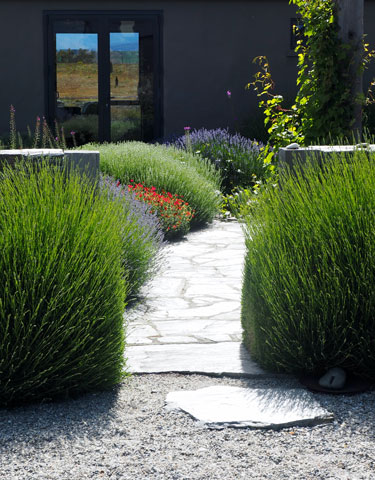
Fragrant lavenders and rock roses flank the path to the front door.
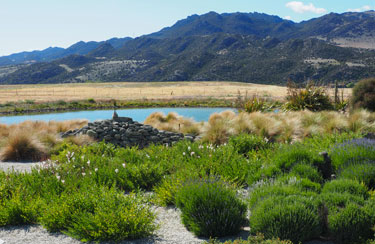
Lavenders and white flowering Gaura with tussock grass and flax echo the colours of the surrounding landscape
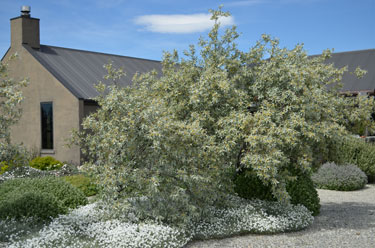
Eleagnus 'Quicksilver' with groundcover Cerastium tomentosum
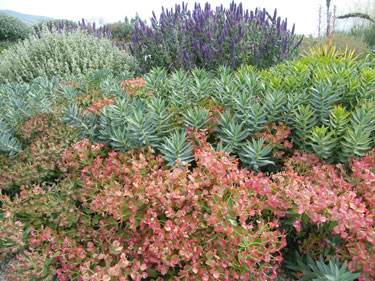
Summer colour of Euphorbia and Echium
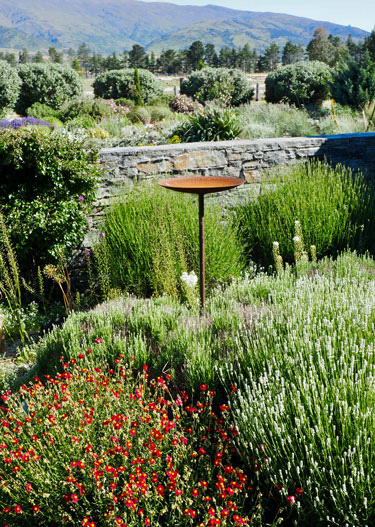
Lavender and rock rose
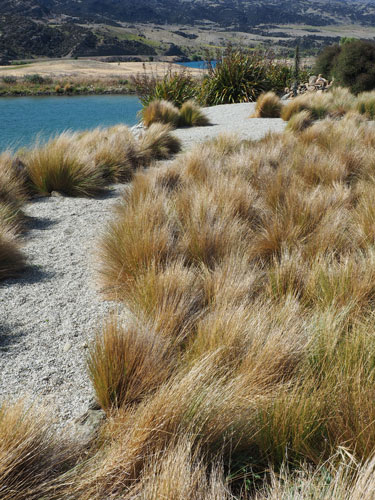
Mass planted silver tussock (Poa cita) is spectacular in bright sun and wind

